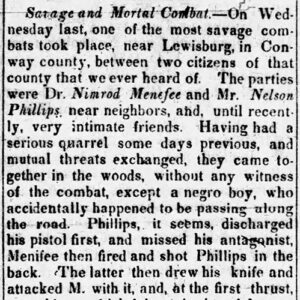calsfoundation@cals.org
Nimrod P. Menifee (1800–1842)
Nimrod P. Menifee (spelled “Menefee” in some records) helped to found and settle Conway County, donating the land that was used for the seat of government in Lewisburg in 1831. He also was involved in some of the bitter disputes and duels that were the outgrowth of the early political tensions in the Arkansas Territory. He developed significant land holdings and was instrumental in the formation of several early settlements in central Arkansas including Lewisburg (later Morrilton), Point Remove, Oppelo, and the town that bears his name, Menifee—all in Conway County.
Nimrod Menifee was born in 1800. The Menifee family first came to this area from Kentucky, beginning in 1818, when the oldest son, Jonas, bought a one-quarter interest in the Cadron Settlement. Having trained to be a doctor, Nimrod Menifee himself came about 1820, ostensibly to manage the property, though he may have actually come to escape the wrath of the associates of a man he had killed in a duel in Kentucky to avenge a dishonor to his younger sister.
Cadron was considered for a time as the new state capital, to replace Arkansas Post, but the proponents of Cadron lost their battle over the placement of the territorial capital and county seat to Little Rock (Pulaski County) interests. Menifee continued to live in that part of the state and was elected, in 1831, to a seat in the House as the representative from Conway County. He was also elected to the Constitutional Convention of 1836 but did not serve in the newly created General Assembly.
Menifee was also involved in many of the political disputes and a few of the significant duels that occurred as Arkansas Territory moved toward development and statehood. One of his confrontations was with publisher William Woodruff, who attempted to draw a pistol on Menifee and whom Menifee tried to attack with a cane. He served as surgeon, friend, and second in many of these duels, one of which involved two justices of the Arkansas Superior Court, Andrew Scott and Joseph Selden.
Another older brother of his, Richard, was an early arrival in Arkansas and was the Pulaski County recorder when Menifee registered as agent for the Cadron property. Through their association, they gained large tracts of land in the newly created Conway County and laid out and incorporated the present town of Oppelo. Menifee was one of three founders of the settlement of Lewisburg and married Harriet Lewis, the daughter of the namesake of the river port community, in 1824; only one child of theirs is known to have survived to adulthood. Menifee donated the land that enabled Lewisburg to become the seat of county government. The Menifee family lived in that developing community, which later had more than 2,000 residents.
While being involved in land development and medicine, Menifee continued his dedication to the “code duello” even after it had been outlawed in Arkansas. He was killed by a man named Phillips in a knife-pistol duel on January 29, 1842; Phillips subsequently died from the pistol wound he received from Menifee. Menifee is buried in the Old Lewisburg Cemetery in Conway County.
For additional information:
The Biographical and Historical Memoirs of Western Arkansas: Yell, Pope, Johnson, Logan, Scott, Polk, Montgomery, and Conway Counties. Easley, SC: Southern Historical Press, 1978.
Sherwood, Diane. “The Code Duello in Arkansas.” Arkansas Historical Quarterly 6 (Summer 1947): 186–197.
Shinn, Josiah H. Pioneers and Makers of Arkansas. Baltimore: Genealogical Pub. Co., 1967.
Larry Taylor
Springfield, Arkansas
 Louisiana Purchase through Early Statehood, 1803 through 1860
Louisiana Purchase through Early Statehood, 1803 through 1860 Supreme Court of Arkansas
Supreme Court of Arkansas Menifee/Phillips Duel Story
Menifee/Phillips Duel Story 




Comments
No comments on this entry yet.